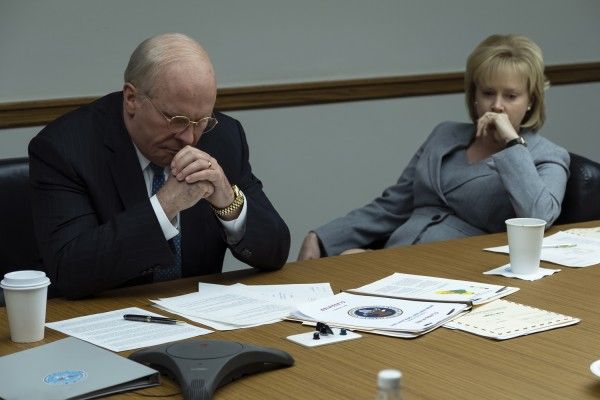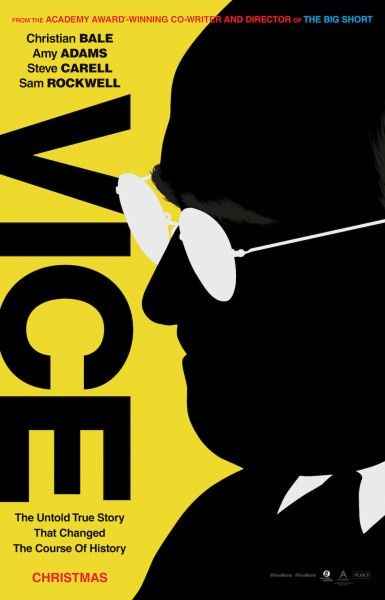Minor spoilers ahead for Vice.
Vice is an inherently controversial movie. The film has been incredibly divisive among critics, coming in at a 65% rating on Rotten Tomatoes despite being pegged as an awards heavy, and it’s even more unpopular with audiences as evidenced by the dismal C+ CinemaScore (anything less than a B+ on CinemaScore and you’re in trouble). To be fair, the film has some uneven moments, but as I said in my review, I see it as a companion piece of sorts with Adam McKay’s previous film, The Big Short, where he seeks to blend entertainment with education for his audience.
Nowhere is this clearer than in the mid-credits scene of the film. Using the focus group that had been featured previously in the message testing for the Iraq War and changing the name of the Estate Tax to the “Death Tax”, we come back to this group and a fight breaks out between a conservative member and a liberal member over the merits of Vice. McKay then turns the camera to a young woman who’s clearly supposed to signal as a young millennial, and she says, “I can’t wait to see the new Fast & Furious movie. It’s going to be so lit.”
Some people have taken umbrage with this moment citing it as not only dismissive, but also hypocritical. It targets a specific demographic as somehow less socially aware, and then tries to blame entertainment like Fast & Furious even though McKay’s filmography includes broad comedies like Anchorman: The Legend of Ron Burgundy and Talladega Nights: The Ballad of Ricky Bobby. If his critique is that young people have ignored politics in favor of mass entertainment, isn’t he equally to blame?
But my read on the scene isn’t that McKay is saying, “If not for those darn Fast & Furious movies, people would have paid attention!” Rather, McKay is taking issue with two things: engagement and age, and the statistics bear him out on this. If you look at the 2016 Presidential Election, voter turnout was about the same with 2012—about 58% off the electorate. But when you break it down by age range, young people consistently lag behind other age groups. Although in 2016 young voters ages 18 to 29 (the age group for the young woman in the scene) rose by 1.1%, that only brings the total to 46.1% for young voters, well behind the next age group of 30-44 (58.7%) and far behind citizens 65 and older (70.9%).
The other part of the equation is that if you look at an average 24-year-old, you have to consider what the Bush era means to them. If you’re 24 today, then you were only seven years old when 9/11 happened. Coincidentally, I was around seven the first time the World Trade Center was attacked, so I know that these kinds of events are hard to convey to someone that age. If you’re 24 today, you were 14 when the financial collapse of 2008 happened. I was 15 when the tech bubble burst, and so again, I realize the kind of impact these massive events have on young people, and the answer is: not much. It’s not that seven-year-olds or 14-year-olds should be boning up on world events. It’s that it’s easy for them to miss these events entirely, and someone needs to come along and share this information when they’re at an age where they can better understand it.
Furthermore, McKay knows that if you want to reach people, you have to be entertaining. That’s not an indictment of entertainment like Fast & Furious, but an acknowledgement that movies like that are what people want to see. In 2010, we got the excellent documentary Inside Job, which breaks down how the financial collapse happened and the consequences of it. The film made $7.8 million worldwide. In 2015, we got The Big Short, which also tackled the financial collapse, but did so in a more mainstream, entertaining fashion. It made $133 million worldwide. By any metric, far more people went to see The Big Short than Inside Job, even though they’re both great movies.
If he wanted to, I’m sure Adam McKay could have directed a dry documentary about the Bush era with Dick Cheney as the focal point. I’m sure he could have attempted to dive into Cheney’s psyche and tried to explore what makes him tick as though that would have any effect on the Republican Party’s slide into authoritarianism. Instead, he made a film for the young woman at the end of Vice. The final scene isn’t a criticism of her as much as it’s a recognition that Americans want to be entertained above all else. The final scene of Vice isn’t here to dismiss entertainment, but to acknowledge that the only way to reach people with serious subjects about recent American history is to package it with a million spoonfuls of sugar. That may be damning, but if you think we’re not amusing ourselves to death (to borrow the title of Neil Postman’s scathing 1985 book), check out the former reality TV star in the White House.



